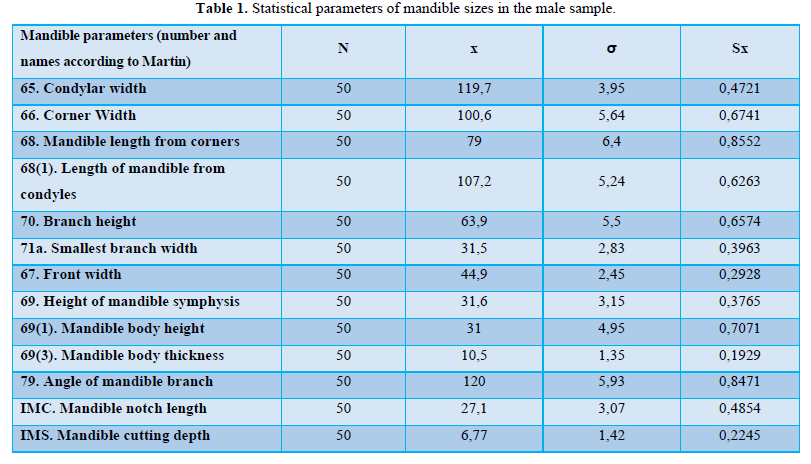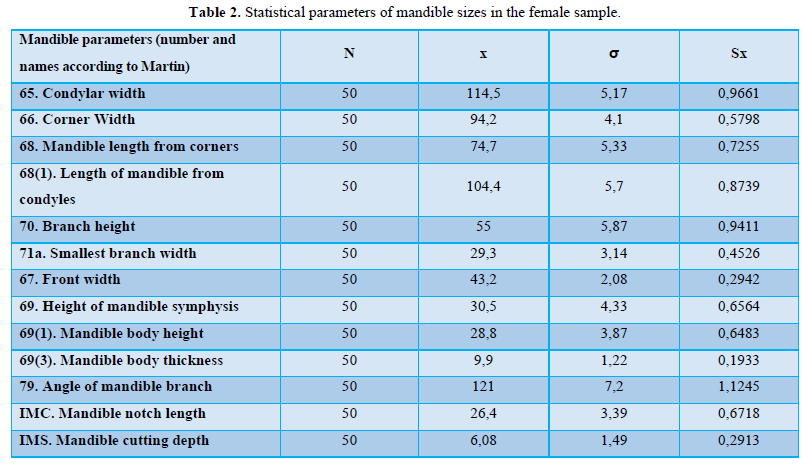1656
Views & Citations656
Likes & Shares
MATERIALS AND METHODS
The material of the study was 100 osteological preparations of the mandible (50 male and 50 female) from the museum collection, which is found in the archives of the Person of Public Law Association of the FME and PA of the Ministry of Health of the Republic of Azerbaijan. We have published in detail about this collection in our previous publications [3,4]. According to the museum's registry, we have information about the gender and age (from 25 to 55 years) of the individuals whose bones were examined. On each preparation, we measure 13 different parameters of the mandible. When taking measurements, we adhered to generally accepted standards recommended by Rudolf Martin [5]. Various tools and devices were used: digital caliper (accuracy 0.01 mm), caliper (accuracy 0.1 mm), measuring tape, goniometer, mandibulometer (accuracy 1.0 mm; 1о), coordinate caliper (accuracy 0.1 mm). The measurement results were analyzed using standard statistical procedures [6], as well as discriminant analysis [7]. Mathematical modeling and calculations were carried out using the Microsoft Excel (version 2016) and MATLAB (version 8.6) software package.
RESULTS OF THE STUDY AND THEIR DISCUSSION
As we noted above, the main part of our work was carried out as part of a large project to study the craniological and craniometric features of Azerbaijanis. Therefore, we note that even on the mandible, we studied much more features than those presented in this publication. A link to our previous work is available in the publication [3], which is presented in the bibliography. In this article, we present the basic statistical characteristics, 13 parameters of the mandible studied by us, separately in the male (Table. 1) and separately in the female (Table 2) samples.

The statistical indicators of the studied parameters did not reveal any noticeable fluctuations in the context of interpopulation differences. Our data are in good agreement with the data obtained on other Caucasoid series [8,9]. Using numerical indicators, we analyzed the differences between male and female mandibles. The results show the presence of higher mean values in men compared to women in all parameters of the mandible. The most pronounced imbalance is between the mean values of the following mandible dimensions: condylar width, angular width, mandible length from the corners, branch height. These results showed certain prospects that would make it possible to build a mathematical model for predicting the sex of a person according to the parameters of the mandible.
Thus, the possibility of determining the sex of the subject in any way based on the parameters of his mandible appeared logically. Based on these assumptions, we decided to use univariate ANOVA to evaluate the feasibility of creating a diagnostic model for mandible sex determination (based on univariate discriminant analysis). To do this, we first clarified the categories of values of those parameters of the mandible that were associated with sex. Then the boundaries of 5 gradations for these parameters were determined and a diagram of the corresponding diagnostic table was built. Our gradations included intervals (range of change in mandible size), the presence of the mandible parameter in one of which made it possible to diagnose 5 outcomes: reliably male, probably male, indeterminate result, probably female, reliably female. Note that these are still preliminary data that have not been implemented in the working methodology (we are also considering other metric features of the mandible, and the final results have not yet been obtained). In Table 3, we present a preliminary plan-scheme, which may form the basis of a methodology for diagnosing sex by the parameters of the mandible on the skulls of Azerbaijanis.

Thus, statistical processing of the results of measuring various parameters of the mandible shows that in the population of Azerbaijanis, certain craniometric features (mandible parameters) have pronounced sexual dimorphism. Morphologically, dimorphism is expressed in the difference in some total parameters of the mandible.
With the help of discriminant analysis, we revealed a fairly strong predictor (for predicting sex) potential of some mandible sizes. This fact opens up opportunities for creating a future diagnostic model for determining sex by mandible size. However, an important condition for the implementation of this task is an increase in the amount of material studied (at least 100 preparations of the mandible from male and female skulls). In addition, it is necessary to search for additional metric features on the mandible, which will have a good predictive potential for predicting sex. It is quite possible that the found number of parameters with sexual dimorphism will not be sufficient for the indicated purpose. In this scenario, to create a diagnostic model, we plan to test algorithms based on the apparatus of fuzzy logic (this does not require a large array of differentiating elements).
CONCLUSIONS
Separate parameters of the mandible on the skulls of modern Azerbaijanis have signs of clearly expressed sexual dimorphism. This is manifested in the predominance of the total parameters of male mandibles over female ones. The obtained results show the possibility of constructing diagnostic models that will allow predicting the sex of a person according to the parameters of the mandible. In addition, the results concerning the average dimensions of the mandible may be of interest for comparative studies by craniologists and anthropologists.
- Iscan MY, Steyn M (2013) The Human Skeleton in Forensic Medicine. Charles C. Thomas, Springfield, IL pp: 515.
- Musayev SM (1997) Possibilities of craniometric studies in the forensic medical identification of the personality of the inhabitants of the Caucasus. Abstract of the dissertation of a doctor of medical sciences. Moscow 40.
- Ibragimov AS, Kerimov ZM (2023) Determining the Length of the Human Body from the Size of the Skull. J Forensic Sci Criminal Invest 17(3): 555963.
- Musayev SM, Kerimov ZM, Ibragimov AS, Orudjov NN (2022) The effectiveness of logistic regression equations for solving problems of determining the sex of a person by odontometric parameters. Int J Forensic Med 4(2): 1-7.
- Martin R, Saller K (1962) Lehrbuch der Anthropologie in systematischer Darstellung. Stuttgart: Gustav Fischer Verlag 2: 579-991.
- Glantz ST (2011) Primer of Biostatistics. 7th (Edn.). McGraw Hill Professional pp: 320.
- ibm.com/docs/ru/spss-statistics/25.0.0?topic=SSLVMB_25.0.0/spss/base/idh_disc.htm
- Bass WM. Human Osteology (2005) A Laboratory and Field Manual (5th). Missouri Archaeological Society, Columbia 36.
- Iscan MY, Helmer RP (1993) Forensic analysis of the skull: Craniofacial analysis, reconstruction, and identification. New York: Wiley-Liss pp:
QUICK LINKS
- SUBMIT MANUSCRIPT
- RECOMMEND THE JOURNAL
-
SUBSCRIBE FOR ALERTS
RELATED JOURNALS
- Journal of Spine Diseases
- Journal of Clinical Trials and Research (ISSN:2637-7373)
- International Journal of Clinical Case Studies and Reports (ISSN:2641-5771)
- Ophthalmology Clinics and Research (ISSN:2638-115X)
- International Journal of AIDS (ISSN: 2644-3023)
- International Journal of Surgery and Invasive Procedures (ISSN:2640-0820)
- Journal of Immunology Research and Therapy (ISSN:2472-727X)

